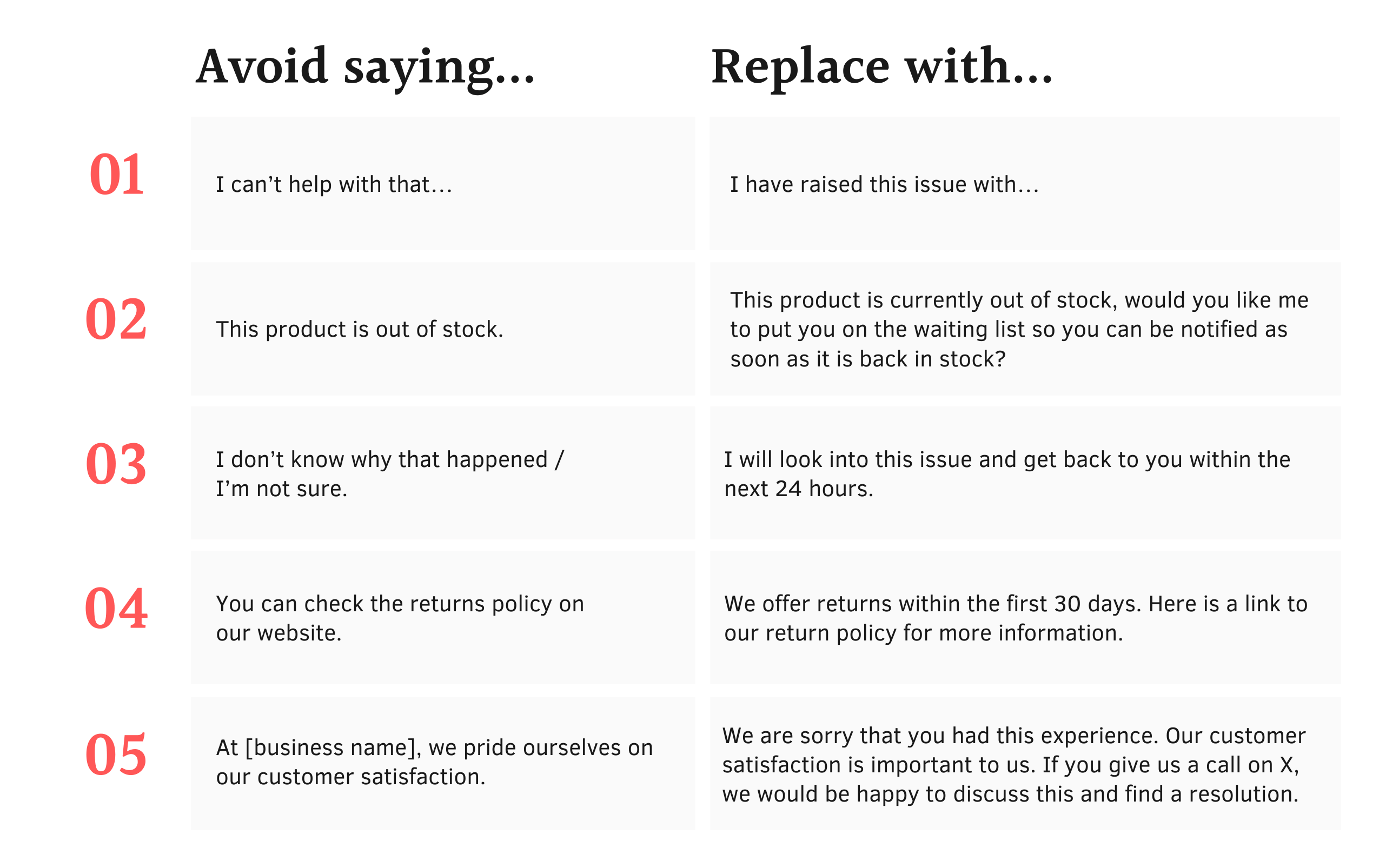Words to Use and Words to Lose – Communicating Online
Making a good impression with your customers matters, and being online is no different. It’s inevitable that you will get a negative review at some point, and it can be difficult to know the best way to address the situation. Whether dealing with positive comments or a major PR crisis, you need to understand these communication fundamentals.
Why Does Communication Matter?
Communication is at the heart of all human interactions. But how can communication directly impact profits? The short answer is customer retention.
Research has found:
“Acquiring new customers can cost 5 times more than retaining current customers”.
Reducing customer defection rate by only 5% can increase profits by up to 125%, depending on the industry.
Improve your customer’s experience through solid communication tactics and they will keep coming back.
Dealing with customer comments online
Whether dealing with good or bad comments online, the communication foundations are the same. You can’t control what others say about your business, but you can control how you respond.
Always Respond
The first step to communicating online is making sure you actually do it.
Respond to both positive and negative comments on all your social media platforms and Google My Business. This includes posts on your Facebook business page, reviews, direct messages, and comments on status updates or posts. While you don’t have to respond to every single social media comment, you should definitely read through and respond to the main ones. When it comes to reviews, ensure you respond to every review.
To make your life easier you can create a database with responses to common questions. This helps to maintain consistency.
Keep it professional & Maintain Brand Voice
Start by defining your brand voice.
Think about who your customers actually are. While your product may have a lot of technicalities, does the person commenting understand these terms? While social media platforms may feel more casual, this isn’t an excuse to lose professionalism. Even if targeting a younger audience, try to avoid too much slang and casual language.
Once you’ve determined your brand voice, stick to it and make sure that anyone communicating with customers follows this.
Dealing with Negative Comments
Start by Focusing on the Positive
Sometimes a negative review is not all negative. A customer may reference positive aspects of your business, such as buying your product for its low price, choosing your hotel for its great location, or choosing your restaurant for its family-friendly focus. Focus on these first in your response.
If they haven’t mentioned anything positive, you could start by thanking them for choosing your business service/product.
Examples:
- We are glad you enjoyed [positive thing 1] about our business.
- Thank you for choosing our [service/product].
Then you can start to address their specific concerns.
Avoid language such as “I can’t”, and “I don’t know” that suggests you cannot solve their problem, or you lack knowledge. Ensure your language is reassuring and proactive by using phrases such as “I can” and “I will”.
Examples:
- Instead of “I don’t know why that happened”.
- Say “I have looked into this issue” or “let me find out for you…”
Fix the Issue on The First Interaction
Always ensure your customer walks away from the first interaction with a resolution.
Even if it may not be possible to fix the entire problem, you should leave them with some sort of solution. If you can’t directly fix the issue on the first interaction, you can let the customer know that you have contacted the support team who will get back to them in 48 hours.
This takes the onus away from the customer and puts it on the business, so they don’t feel frustrated continuing to follow up on the same problem.
Be Specific – Avoid the Copy & Paste Trap
Avoid general statements and be specific in your response and looking into your customer’s concern.
While we mentioned you can create a database of template responses, you don’t want to fall into the copy and paste trap. Use these as a guideline, but treat each response as unique. If you run an eCommerce store and a customer mentions a particular product, reference that exact product in your response. For example, “black Adidas sneakers” is more concrete than simply “shoes”.
Take the Issue Away from the Platform
While it is important to be specific, avoid being too in-depth on a public platform. Wherever possible try to take the conversation away from the public.
Use these phrases to move to a private conversation:
- If you’d like to give us a call on X, we’d be happy to discuss this further.
- We’ve sent you a dm to discuss this issue.
Be Timely
As a rule of thumb don’t take more than one day to respond.
Customers want to feel heard and usually head to social media for quick responses. If you take too long, they are likely to become frustrated and you could lose long-term customers.
Don’t Delete Negative Comments
When it feels like things are spiraling out of control it may seem tempting to just delete the comments you don’t like. Instead of deleting them, keep them there to show your business is transparent and helpful to custom concerns.
Remember, you cannot delete Google My Business reviews.
Be Human
You’re human, so sound like one in your response!
Don’t be overly formal or respond in the third person. Particularly when dealing with negative reviews, if you respond using your business name it can help the negative review appear in searches (which you definitely don’t want!).
Don’t regurgitate sentences from your about us page. To proof check your response think about whether this is something you’d say out loud in real life to an upset customer. If you sound like a robot – change your response.
Be Empathetic – Remember Your Customers Are Real Humans Too
This brings us back to our favourite marketing theory – Maslow’s Hierarchy of Needs. By responding to customers and resolving issues you are promoting a sense of safety and security.
Use words such as “I understand” show you care about their situation, before you get into finding a solution. Never dismiss or disregard their concerns.
View It as An Opportunity
There may be some truth in the saying ‘there is no such thing as bad publicity’. Other than the occasional troll, there is usually validity to your customer’s concerns. If similar issues keep arising, this could be a learning opportunity to pinpoint business issues that need to be addressed.
For example, if a lot of customers are complaining that products are out of stock you may have a supply chain issue. Or if customers are saying that the shipping takes longer than advertised, you may need to go back to your shipping partner to determine what is causing the hold up.
Negative comments also allow you to demonstrate your company’s accountability and transparency. Remember, on social media these comments are public. So other potential customers will see that your business is available and helpful. If you can show that you’ve got great customer service, this will help you build trust, leading to greater customer loyalty and retention.
Dealing with Positive Comments
As well as responding to negative comments and reviews, you should respond to the positive ones!
How to deal with positive comments
- Start by thanking the customer for their review/comment.
- Mention your business name in response to a Google My Business review to improve visibility in search engines.
- Get more positive reviews on GMB by sending customers a direct link to your page.
Key Takeaways
Write Responses That Suit the Platform
Responding to negative comments on posts on social media:
- Don’t draft your response like a formal email.
- Don’t sign off with a name at the end of your reply.
- Keep the response short and sweet limited to 1-2 sentences.
- Move the conversation to a private message.
Responding to positive comments on posts on social media:
- Remain fun and engaging while maintaining brand voice.
- No need to respond to every comment.
Responding to negative reviews on Google My Business
- Mention the customer’s name.
- You can sign off with your own name.
- Respond from the business profile (don’t use your personal Google account).
- Move the conversation to a private call.
Responding to positive reviews on Google My Business
- Mention the customer’s name
- Thank them for the review
- Try to respond to every review








